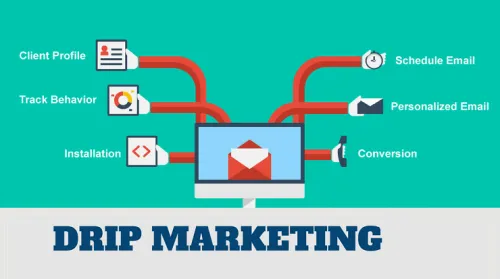In a world inundated with instant gratification, the subtle art of persistent marketing often gets overlooked. Yet, there lies magic in the slow, steady, and consistent approach of drip marketing – a strategy that nurtures leads and builds customer relationships over time. This article delves into the essence of drip marketing, unraveling how a gradual, persistent approach can yield remarkable results for businesses.
1. Understanding Drip Marketing
Drip marketing is a communication strategy that sends, or “drips,” a pre-written set of messages to customers or prospects over time. These messages, often in the form of emails, are sent based on specific timelines or user actions, ensuring relevance and timely engagement. This method stands out for its precision and patience, focusing on long-term relationship building rather than immediate sales.
2. Crafting a Successful Drip Campaign
The success of a drip campaign hinges on understanding your audience and delivering content that caters to their interests and needs at different stages of their journey. Start by segmenting your audience, tailoring messages for different demographics, behaviors, or stages in the sales funnel. Each message should be purposeful, adding value and gently guiding the recipient towards the next step.
3. Benefits of Persistent Marketing
- Enhanced Customer Engagement: Drip campaigns keep your audience engaged over time, providing regular touchpoints that build familiarity and trust.
- Increased Conversions: By providing timely and relevant information, drip campaigns can nurture leads more effectively, leading to higher conversion rates.
- Customer Education and Retention: These campaigns are excellent tools for educating customers about your product or service and for keeping your brand top-of-mind, enhancing customer retention.
4. Examples of Effective Drip Campaigns
- Welcome Series: Introduce new subscribers to your brand, setting the stage for future communication.
- Educational Content: Share tips, insights, and resources that align with your audience's interests and needs.
- Re-engagement Campaigns: Rekindle interest among inactive subscribers by reminding them of your value proposition.
- Post-Purchase Follow-ups: Enhance customer experience with useful information or support related to their purchase.
5. Measuring the Success of Drip Marketing
Success in drip marketing is measured not just in direct sales but also in engagement levels, open rates, click-through rates, and customer feedback. Monitor these metrics closely to understand the effectiveness of your campaigns and to make data-driven adjustments.
6. Combining Persistence with Patience
The key to effective drip marketing is balancing persistence with patience. Your messages should be frequent enough to keep your brand relevant but spaced out enough to avoid overwhelming your audience. This balance is crucial in building a relationship that feels natural and not forced.
7. The Role of Automation in Drip Marketing
Leveraging automation tools can significantly enhance the efficiency and effectiveness of drip campaigns. Automation ensures timely delivery of messages, consistent communication, and frees up valuable time for strategizing and creative thinking.
Conclusion
Drip marketing is a powerful strategy that combines the magic of persistence with the art of subtlety. It’s about building relationships, nurturing leads, and delivering value drip by drip. In an age where loud and aggressive marketing tactics often drown out the message, a well-crafted drip campaign can be a breath of fresh air, quietly and effectively winning over your audience. For businesses looking to build lasting relationships with their customers, the persistent, patient approach of drip marketing can indeed work like magic.



